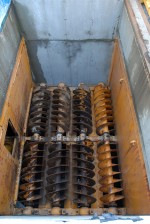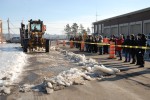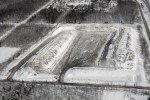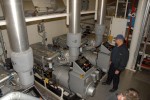
|
|


Every Congress delegate had the opportunity to sign up for one of seven technical visits planned for Wednesday afternoon. Each visit included one stop at the International Snowplow Championship before or after the facility visit, as the case may be. Each Congress delegate has thus been able to attend part of this unusual international competition.
The principles for the harmonization of maintenance contracts between adjacent territories and the distribution of operations between the ministère des Transports and the private sector have also been addressed.
Lastly, visitors had the opportunity to learn about snow removal and de-icing procedures as well as to see the vehicles and equipment used for these maintenance operations.

The Centre intégré de gestion de la circulation de Québec [Québec integrated traffic management centre] is a key facility for monitoring the road system in an area comprising more than 15,000 kilometres of road under the ministère des Transports's responsibility, including the urban agglomeration of the City of Québec. It serves as a 24 hours a day year-round gateway to the Ministère for requests for action and information, including for emergency response events. It serves a clientele composed of employees, road users and various partners such as police forces, emergency services, municipalities and transportation organizations.
Through its team and telecommunications, traffic control and road monitoring activities, the Centre strives to increase the safety of road users and improve traffic flow by providing better knowledge of the network's state and use, as well as through priority actions.
In its newly built cutting-edge offices, visitors learned more about the Centre in general, the system used to monitor road conditions in winter, the telecommunications control software and the traffic control tools (network of cameras and changeable message signs) as well as about weather watch and road monitoring operations.
The visit took place in two stages. First, participants visited a facility from which the snow removal operations for a district of the city are planned and overseen. They have also been able to examine the equipment used. Second, participants visited the police force's Mission Operation Centre (MOC), where the actions of emergency services are coordinated during major weather events.

In order to protect the environment, Québec adopted regulations governing the management of waste snow. Indeed, snow removed and transported for disposal must be deposited on an authorized disposal site, thereby forbidding its dumping in waterways like the St. Lawrence.
The removal and transportation of the more than 300 cm of snow that falls every year within the City of Québec's land area have forced the latter to manage and store a very large quantity of snow at its various snow dumps. To reduce these volumes in an environmentally friendly manner, the City of Québec designed, in 1998, a machine to melt the snow collected on roads. This machine uses solar power and geothermics to heat and store the water needed to melt the snow. Close to 60,000 m3 of snow is processed every year by the melter.
Participants watched a video presenting the snow melter as well as view the equipment and observe the latter's operation.
As regards the environmental aspect in particular, the layout of these sites makes it possible to manage various contaminants having an impact on water quality. Monitoring activities that include the sampling of ground and surface waters are carried out on an ongoing basis to make sure the facilities adequately fulfill their role.
The five sites are supervised by a single person, thanks to the implementation of a computer-based management system. The benefits thus ensured include improved control over operations and costs as well as better overall efficiency. This technology was developed by the City of Lévis in collaboration with the software provider.
Congress delegates have been welcomed for a visit to the waste snow disposal facility at the des Moissons site, followed by a demonstration.
During this visit, Congress delegates heard about the company's management policy as well as the policy for the safe handling of users in winter as in summer, including the issues associated with the diversity of user needs, depending on whether they are travelling by foot or by car. On the same occasion, themes associated with regulation and environmental considerations in relation to shore-to-shore navigation have also been integrated in the visit.

The Québec City Jean-Lesage International Airport proposes a visit in a setting where the winter maintenance operations differ as much due to the criteria used to analyze the condition of aircraft circulation areas (brake index, width cleared, remaining width, percentage of ice, powder, hard snow, wet snow, height of snowdrifts, etc.) as the special features of the snow removal equipment (high-speed runway sweepers, 5,000 ton/hour snowblowers operating at more than 40 km/h). The runway surface friction coefficient (CRFI), obtained using an electronic decelerometer, is the main tool used to analyze and inform pilots of runway conditions.
Subject to major time constraints, ever-stricter standards and ceaseless evolution in the field of aeronautics, passenger safety remains a priority. Québec City's airport also significantly improves its performance on an ongoing basis to reduce runway downtimes: three to five hours per season.
The technical visit at the airport allowed visitors to discover the equipment used to determine runway conditions and make them usable, as well as help them understand working methods and decision-making processes.
|
To facilitate reading of the text, the masculine is used without any discriminatory intent. |



